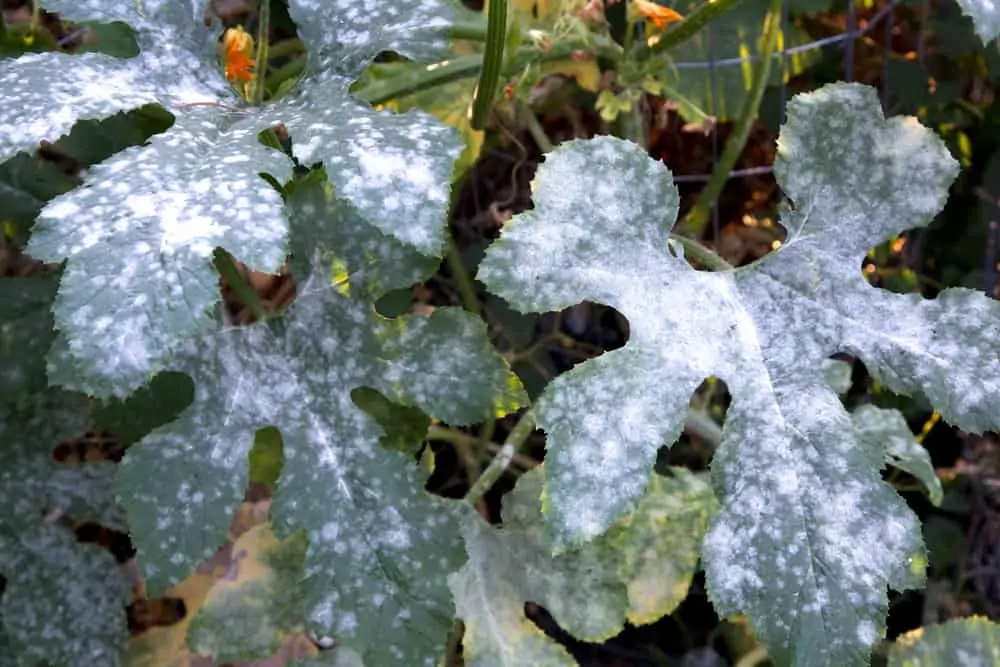If you’re a keen gardener then you’ve probably seen powdery mildew at some time or another. This common problem is unlike regular mildew. Where most mildew prefers the cold and the damp, powdery mildew thrives in the dry.
It’s easily missed at first, appearing like dust that can just be swept away with a finger. Then it comes back.
Powdery mildew can spread quickly and to almost any plant. The loose spores grow heavier and can cover the leaf. Left untreated, powdery mildew may end up destroying your garden.

Luckily, it’s treatable. The best measures are preventative, but stay on the lookout in your garden, especially if it’s a small space with poor air flow. Powdery mildew presents as small, light spots in gray and white that appear on the tops and bottoms of plants.
As it gets worse, the spores grow larger, and eventually the leaves begin to whither. At this point, the infection is advanced, and you should take action immediately.
Table of Contents
Should I remove leaves with powdery mildew?
Yes. Once a plant has become infected with powdery mildew it can quickly spread to the rest of the crop. Remove the infected leaves to try and prevent the spread.
Dispose of removed leaves rather than composting them, as the spores may continue to live in the compost. Wash your hands/gloves after removing the leaves, and treat the clippers with cleaning products to kill the spores.
While removing the leaves is a good step, especially for limited mildew growth, it’s only a first step. Once powdery mildew has appeared, the plant should be treated to avoid the mildew spreading. Spray the plants with either a fungicide or a homemade solution regularly.
Powdery mildew is often a sign of poor growing conditions. If you’ve been struggling with powdery mildew, then once the spores have been removed assess your growing conditions. Plants need a good airflow, and regular exposure to sunlight.
Is powdery mildew harmful?
For the plant, at first powdery mildew is just an ugly blight. However, when left too long it begins to suck the nutrients out of the leaves. Eventually, this will cause the leaves to wither, yellow, and die.
Left even longer, and the mildew will begin to prevent plants from flowering, and it can change the flavors of any fruits and vegetables effected. Powdery mildew can infect almost any kind of plant, from flowers to trees, so treat it before the entire garden becomes damaged.
For humans, powdery mildew can cause harm indirectly. Powdery mildew can infect fruits and vegetables. When these plants become infected, it’s less likely that it will produce fruit. If they do, then the fruit will appear dull, small, and the taste will be changed. These aren’t desirable to eat.
Those with respiratory illnesses or mold allergies should avoid powdery mildew. Most people can touch powdery mildew without it causing harm.
Can powdery mildew be cured?
Yes, powdery mildew can be cured. As a common affliction, there are many solutions available to treat powdery mildew. From commercial fungicides to homemade remedies, if you have powdery mildew there should be a way to remove it.
Be careful, because mildew can survive in soil and over winter. When curing powdery mildew, act fast and stay alert for any reappearance. At a low level, powdery mildew is an inconvenience rather than harmful.
The greatest cure for powdery mildew is to treat it before it occurs. To do this, make sure your plants are growing in the best conditions. Ensure there is good air circulation by not crowding plants.
Avoid areas of shade by growing in areas where plants will get several hours of sunlight a day and cutting back trees and overgrowth. New plants are particularly susceptible to powdery mildew, so avoid over fertilizing. Good draining also prevents the growth of powdery mildew.
Does powdery mildew stay in the soil?
Yes, powdery mildew can stay in the soil. However, with proper care it can be removed. Powdery mildew spores grow over winter, before thriving in the hot summer weather.
In the fall, remove the plants and fallen leaves that were infected with the mildew. Tilling the soil helps, as it exposes the spores to harsher winter conditions.
If you’ve had an issue with powdery mildew, treating the plants with fungicide before signs of infection appear can stop it from growing. A baking soda solution will treat the soil before the spores are able to multiply.
Preventing the soil from getting too damp, or too dry, will also halt the growth of powdery mildew.
What is the best fungicide for powdery mildew?
There are multiple commercial fungicides that can be used to treat powdery mildew. As it’s such a common affliction, many of the most common fungicides can be used as treatment.
Patch Pro contains propiconazole and has shown good results against powdery mildew without damaging the plant. Bonide 811 Copper 4E Fungicide is a natural fungicide that works quickly and can be used safely on fruits, vegetables, and crops. Safer Brand Garden Fungicide has also shown good results.
If you don’t want to try a commercial fungicide, there are homemade options for treating powdery mildew. A preventative measure is mixing 1 tablespoon of baking soda with 1 teaspoon of non-detergent liquid soap, in a gallon of water. Spray on plants before powdery mildew appears, and careful application can prevent the problem.
Mouthwash is another affordable, homemade option. 1 part mouthwash with 3 parts water creates a powerful spray, so be careful when using on new growth. However, the anti-bacterial properties of mouthwash can kill the germs causing powdery mildew.
Similar to mouthwash, apple cider vinegar mixed with water can treat powdery mildew. It works best in a higher concentrate, but is more likely to damage plants the stronger it is. Per gallon of water, 2-3 tablespoons of vinegar is recommended.
An unusual option that’s quickly gaining traction is milk. There’s yet to be a clear understanding of why, but 1 part milk to 2 parts water has been shown to be effective at treating powdery mildew.
It’s believed that there are naturally occurring compounds in milk that both kill disease and improves the plants immune system.
Before using any treatment, start by spraying a small area of the plant or garden to see how it reacts. Especially if using a homemade formula. This checks the plants’ reaction to the treatment, and allows you to make any potential changes.
Will powdery mildew go away on its own?
A mild case of powdery mildew may go away on its own, but treatment is recommended. Powdery mildew can spread fast, especially in warm conditions, and it can infect almost any type of plant.
An untreated case of powdery mildew may quickly destroy a garden, and come back year after year. Powdery mildew may seem innocuous at first, but it very easily becomes an unsightly blemish. Left too long, it can cause real damage to your plants, especially fruits and vegetables.
If you have powdery mildew, then there are easy, homemade solutions, that can tackle the problem. The best solution is a healthy growing environment, with well spaced planting and adequate sunlight.

